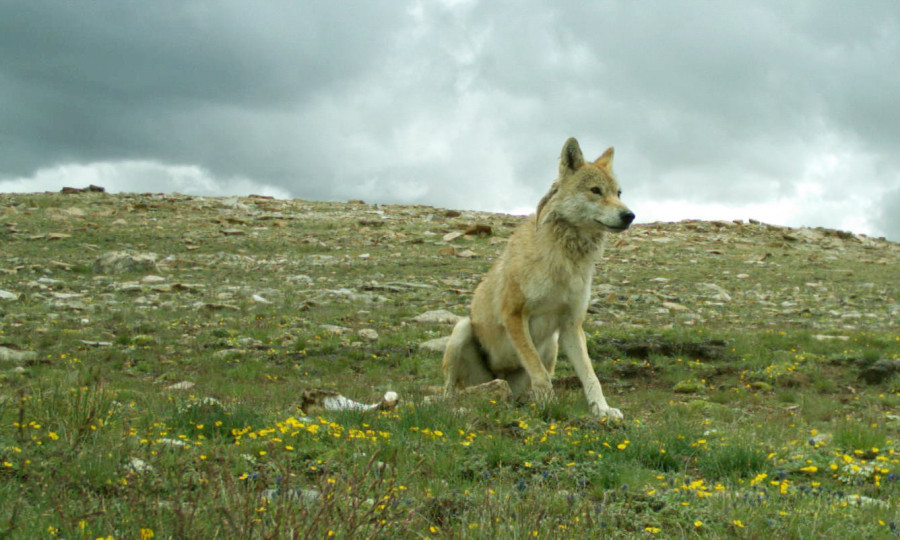National
Himalayan wolf awaits special recognition as subspecies, if not as an entirely new species
A series of studies over the years concluded that Himalayan wolves have adapted genetically to survive in high altitudes, a quality that makes them different from other wolf species.
Chandan Kumar Mandal
The series of research compiled and published in the Journal of Biogeography gives strong evidences that Himalayan wolves should be recognised as a subspecies of the grey wolf, if not as an entirely new species, for its unique adaptation and surviving characteristic.
According to the study, Himalayan wolves possess a unique genetic adaptation to survive in the high-altitude region with a oxygen level—a quality unlike in any other wolf species.
Riding on this high-altitude gene that helps these mountain-dwelling wolves survive lack of oxygen, the researchers are asking for the recognition of the Himalayan wolf formally as a subspecies, with its own scientific name.
“The outcome of this research is absolutely astonishing. When we started out in 2014, it was surprising how little was known about these wolves inhabiting a relatively large region of our planet,” Geraldine Werhahn, a doctorate student at Oxford University’s Wildlife Conservation Research Unit and lead author of a study, was quoted on University’s website. “At the time, the scarce data available was indicating a genetic difference, but we had no explanation for why these wolves are different from a grey wolf.
The team led by Werhahn had studied 280 wolf scat samples from western China, Kyrgyzstan and Tajikistan to find out the Himalayan wolf’s evolutionary uniqueness based on many different genetic markers. The study revealed that Himalayan wolf, which dwells above 4,000m of altitude, diverged than grey wolf which is found in large parts of North America and Eurasia.
“Now we know that these wolves are different from genetics to ecology, and we have an indication of what the reason may be: the evolutionary fitness challenge posed by the low oxygen levels in the extreme high altitudes,” said Werhahn.
The researchers have concluded that the Himalayan wolf merits taxonomic recognition and designation as an Evolutionary Significant Unit (ESU)—population of organisms that is considered distinct for purposes of conservation.
The research team led by Werhahn, in its previous expedition in 2017, has found out that Himalayan wolves live in the mountain range as well as the Tibetan plateau. Besides, Nepal and China, these animals are also found in the Indian Himalayas and those found nearby Kyrgyzstan were mostly grey wolves.
“When we started this research we thought this wolf is found only in the Himalayas, but now we know that they are found in the entire high altitude regions of Asia comprising the habitats of the Himalayas and the Tibetan Plateau,” said Werhahn, who also leads Himalayan Wolves Project. “Much still remains to be revealed about their ecology, behaviour and population size. But the time to protect them is now!”
According to Naresh Kusi, one of the researchers, the latest findings have established Himalayan Wolf as a distinct species if not completely a new species.
“The research has established Himalayan wolf as a distinct evolutionary unit, meaning it is diverse than the grey wolves,” said Kusi, who is also a research associate at Resources Himalaya Foundation. “We are not calling it a new species right away although it is genetically distinct from other wolves. Full genome analysis is required for establishing it as a new species and taxonomic recognition.”
The researchers have estimated that less than 100 Himalayan wolves dwell in the Himalayan region of Nepal, hence requiring conservation.
The taxonomic recognition will pave the way for the wolf to be given conservation status by the International Union for Conservation of Nature (IUCN), to help protect the population.
The research was based in Upper Humla, upper Dolpa and Kanchhenjhunga Conservation Area, where the sighting of these animals were common. These mountain-dwelling wolves have managed to survive harsh high altitude life, however, are under threat from local communities.
According to Kusi, Himalayan wolf is under threat due to retaliatory act by local communities and negative perceptions about the animal.
“Local communities tend to fear that these wolves would eat their cattle as they can be easily seen around. Use of their parts for unverified medicinal purpose and conservative practices also encourage others to kill wolves,” said Kusi. “In Dolpa, we found locals have set their den on fire. The animal is critically endangered and requires special conservation, which can be easier once it is recognised.”




 8.12°C Kathmandu
8.12°C Kathmandu





.jpg&w=200&height=120)









